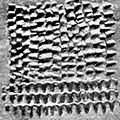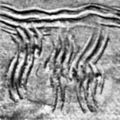Cardial or imprint culture

The cardial or imprint culture or (imprint) ceramics is a group of related cultures of the early Neolithic , which developed in the 7th millennium BC. BC on the eastern Adriatic coast and around the western Mediterranean (including North Africa ) and on the islands of Corsica , Sardinia , Sicily and Malta (but not on the Balearic Islands ). The ceramic decoration was created with the edge of the mussel shells of the cockles ( Cardium spec. ). In the course of time, other decoration techniques are added, comb prints, such as molding and grooving decorations. Therefore the culture was initially called Cardial Culture (in France still Culture de la céramique cardiale ). However, as more and more ceramics appeared that had impressions made with other objects, the term imprint ceramics (often Italian impresso culture ) was introduced.
Origin, related culture
The current state of knowledge of the cardial or imprint culture (s) does not suggest a uniform culture formation. Rather, the ceramics, which are similar in appearance, point to divergent cultures. The other finds, such as stone utensils, but also the ceramics themselves and the different settlement behavior of the people suggested this conclusion. However, it cannot be said with certainty whether this settlement behavior can only be attributed to the geographical and climatic conditions or whether the cultures are different from one another.
Find areas and styles
The earliest archaeological finds of ceramics with such stamp-like impressions are between 6400 and 6200 BC. Dated; their localities are in Epirus and Corfu . Then they appear in other settlements in Albania and Dalmatia , as well as on the east coast of the Adriatic around the year 5900 BC. The earliest finds in Italy come from the archaeological site of Coppa Nevigata ( Foggia province ) on the Adriatic coast in southern Italy. They were dated to 6000 BC. Dated. Cardiac pottery was also made in Sardinia during the early Su Carroppu culture (lower layers in the Coloru cave, 6000 BC).
The oldest ceramic impression on the Iberian Peninsula is often found in caves (e.g. Gruta do Caldeirão near Tomar , Portugal ) on the coast and, with a few exceptions, not in the hinterland . In some Portuguese mussel heaps there are also broken pieces with cardium imprints, which are also found in the Algarve , in the Alentejo and at the mouth of the Mondego .
The initial homogeneity of the imprint ceramic dissolved into several post-impresso cultures. In the area on both sides of the Rhone, this includes the Epi-Cardial culture, followed by the Chassey-Lagozza-Cortaillod culture , which initially received its own name in southern France , northern Italy and southern and western Switzerland , but is now regarded as uniform.
In Portugal, the early period was followed by undecorated vessels with characteristic wall kinks and rim shapes that became common in the 3rd millennium.
Shapes of the bottom of the vessel
In addition to the decoration, the shape of the vessel is also different. The younger pottery is generally flat-bottomed, while the pottery with the cardial patterns is still round-bottomed. The round bottom is the subject of discussions, as the vessels of the Mediterranean Neolithic were flat-bottomed (thus stable) before the emergence of the cardial ceramics.
In the region with cardial ceramics, only one area in Africa had developed round- bottom ceramics, but in a Mesolithic- game-hunter context. Contacts between the bearers of the cardial culture and African hunters and gatherers are controversial.
photos
literature
- Johannes Müller: The East Adriatic Early Neolithic: The Impresso Culture and the Neolithization of the Adriatic Region. 2001. ISBN 3-89166-170-3
- Samuel van Willigen: The early Neolithic in the western Mediterranean area: The Cardial culture . 2001.
- William K. Barnett: Cardial pottery and the agricultural transition. In: Douglas T. Price (Ed.): Europe's First Farmers. Cambridge, Cambridge University Press 2000, p. 96.
- Antonio Gilman: Neolithic of Northwest Africa. Antiquity 48/192, 1974, pp. 273-282.
- Barry Cunliffe : Europe Between the Oceans . In: Staso Forenbaher, Preston Miracle: The spread of farming in the Eastern Adriatic. In: Antiquity 79, 2008/305, pp. 115-116.
- João Zilhão: Radiocarbon evidence for maritime pioneer colonization at the origins of farming in west Mediterranean Europe . In: Proceedings National Academy of Science USA , 98/24, 2001, pp. 14180-14185, PMC 61188 (free full text)
Web links
- Christian Jeunesse, Samuel van Willigen: Western Mediterranean Early Neolithic and Western Linear Pottery: Impulses, Interactions, Mixed Cultures. In: Reprint from: The Neolithization of Central Europe. The Spread of the Neolithic to Central Europe. RGZM - Tagungen, Volume 4, ISBN 978-3-88467-159-7 , Verlag des Römisch-Germanisches Zentralmuseum Mainz 2010, pp. 569–605 academia.edu
Individual evidence
- ↑ Johannes Müller : The East Adriatic Early Neolithic. The Impresso culture and the Neolithic of the Adriatic region. Spiess, Berlin 1994, ISBN 3-89166-170-3 .
- ^ João Zilhão: Radiocarbon evidence for maritime pioneer colonization at the origins of farming in west Mediterranean Europe . In: Proc Natl Acad Sci USA , 2001 Nov 20, 98 (24), pp. 14180-14185, PMC 61188 (free full text)
- ^ William K. Barnett: Cardial pottery and the agricultural transition . In: Douglas T. Price (Ed.): Europe's First Farmers. (2000), p. 96.
- ↑ Hermann Parzinger : The children of Prometheus. A history of mankind before the invention of writing. CH Beck Verlag, Munich 2015, ISBN 978-3-406-66657-5 , pp. 215-222.
- ↑ Staso Forenbaher, Preston Miracle: The spread of farming in the Eastern Adriatic. In: Antiquity , 79/305, 2008, pp. 115-116, additional tables .






